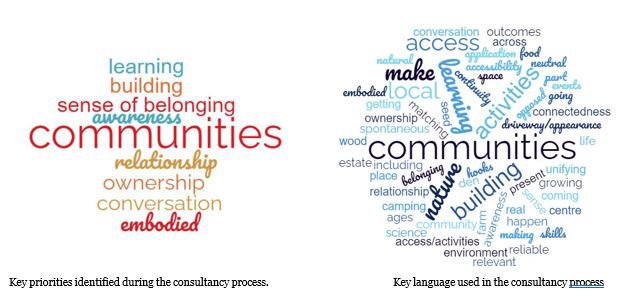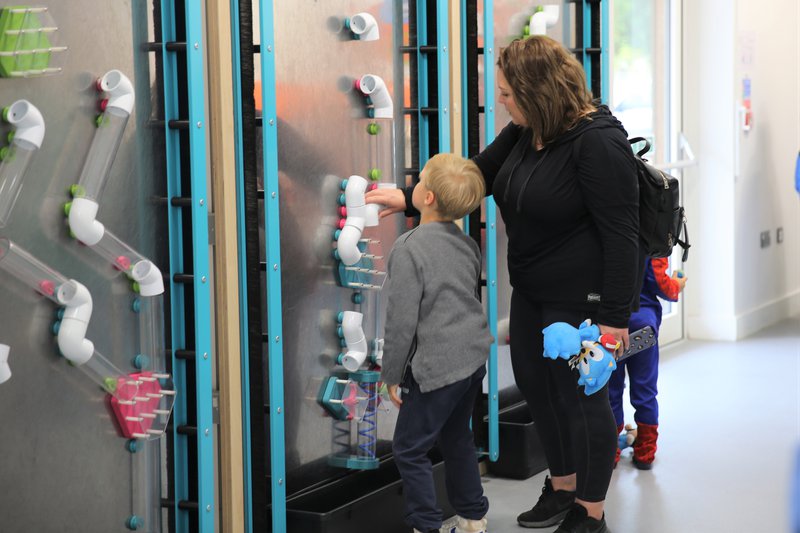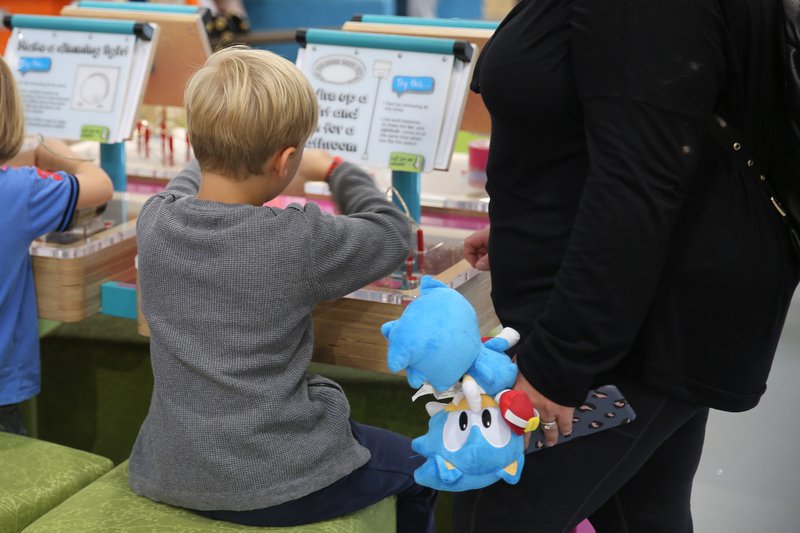‘For Me’ - valuing the individual and your local community
Identified and addressed barriers for engagement with their closest community group Wood Farm, through building trust and co-producing activities.
Who did you work with?
- 4 Community connectors
- 14 Community group leaders from organisations that work with families in Wood Farm, including: Wood Farm Primary School, Oxford Community Action, Wood Farm Youth Centre, local councillors, Bullingdon Community Centre, Youth Ambition. They are individuals who work and/or live in Wood Farm and have experiences valuable to understanding the community drivers and barriers. Following the initial community consultation phase, further work was continued in partnership with Wood Farm Youth Centre and Wood Farm Primary School.
- We also consulted with 12 family groups (40 individuals) across a range of ages about the visibility and accessibility of our site and the Science Oxford Centre.
Had you worked together before?
Prior to this project we had completed some initial consultation work with 4 community connectors who gave us insight and direction for the project and who introduced us to further possible community contacts. This led to some initial work with Oxford Community Action, who visited the Science Oxford Centre for some introductory sessions to get a feel for the space and the nature of our existing work with underserved audiences. Wood Farm Primary School had engaged with our education programme before the pandemic, but staff changes had led to a break in the chain of contact and relationships needed to be re-built.
What priorities did you identify with your partner and how did this project meet the longer-term priorities of everyone involved?
A key priority emerging from the consultancy process was to increase awareness and accessibility of the space and activities of Science Oxford. This echoed longer term priorities that came out of the original consultancy event, which included increase connectedness to centre, accessibility, provide a unifying community space (a ‘neutral’ space), be present on the (Wood Farm) estate. One phrase that summed up the community leaders’ priorities during the consultancy was ‘For Me’ - valuing the individual, the community and making our activities and spaces a place for anyone from the community to feel welcome.

Can you summarise the aims of your project delivery?
The project aimed to increase Wood Farm community dialogue and engagement in activities of the Science Oxford Centre – through identifying and adjusting perceived and physical barriers to accessing the site and participation in our STEM activities.
The project aimed to integrate learning from the consultation phase into Science Oxford’s established education and family programmes.
The project aimed to design and facilitate new Wood Farm community-focused activities/initiatives based on the learning from the community consultation.
Do you have any online resources or webpages we could link to, to find out more?
We have a community page of the Science Oxford website under development as a part of the project.
Summer 2023 events we organised in partnership with the Wood Farm Community as a result of Bold Futures funding: Science Oxford Summer Cinema - Science Oxford
How co-produced was your programme?
- Consultation (set list of options are discussed, involves listening & feedback to which is most appropriate)
- Deciding together (encourages new and additional options, and joint decision making)
- Acting together (not only deciding what is best together, but forming a partnership to carry it out)
What steps did you take with your community partner in order to reach this level of co-production?
Trust-building was important and it took ~3 months to build relationships with the community leaders prior to introducing them fully to the project and aims. Initial consultation was carried out with two community connectors (Rawz and Hassan) and one engagement consultant (Mike) to identify creative ideas, areas of development and potential community contacts. This led to introductory events to begin discussion and initiate trust-building opportunities.
Through the community connector and consultant introductions, we brought 14 community leaders to the Science Oxford Centre. They all worked within Wood Farm or worked with families from Wood Farm. Meeting the community leaders in our space was important at this stage because lack of physical visibility was a main barrier to engagement. They in turn enabled us to consult with 12 family groups from the community. Subsequent meetings to develop activities were typically carried out in the community itself; for example meetings in schools, community centres and youth centre spaces.

“I feel that you are now on track to begin to build the relationships required for Science Oxford to participate meaningfully in and contribute to the community on its doorstep. I feel this has been made possible by the willingness of local people to engage, but also by your (Sian's) willingness to listen and adapt to the recommendations of local consultants.” - Community Connector, August 2023
Can you note down some of the benefits and challenges to working this way?
Benefits
- Working with the community connectors was invaluable – this helped to raise our profile through the introductions to the community leaders and families we were subsequently able to engage with in the consultation.
- The trust-building work with the community leaders contributed to them feeling able to suggest outcomes for the projects that were synonymous with our overall aims.
- Co-production of the activities has increased to the longevity of the consultation phase which allowed time for meaningful relationships to develop. The collaborative practices and changes in culture of our working have been adopted organically because the length of this phase allowed it. This should, along with other evidence of impact gathered during the project, help these changes to working practice to be more sustainable once the project itself has finished.
Challenges
This project revealed the substantial amount of relationship building and groundwork that needs doing in order to co-produce effectively with community groups. This is important but time-consuming work and gains are hard won and easily lost. The project will continue until December 2023 to give us longer to work with the community, to build trust over time, and to internally work out how best to sustain relationships and legacy with limited staff resource once the project is completed.
What was the STEM link?
STEM skills and knowledge/understanding are developed through engagement with our primary science programme, which covers a wide range of curriculum topics and has flexibility to meet requirements of school groups. Our education programmes and Science Oxford Centre content are all based on our evidence-based pedagogy ‘Thinking, Doing, Talking, Science’ (TDTScience). This is an ‘inclusive challenge’ approach which provides opportunities for all children to develop higher order thinking skills through facilitated discussion, questioning and creative practical science.
As well as the Science Oxford Centre content itself being based on the inclusive evidence-based TDTScience ethos and extensive observations of families in science centre settings, all the community events also included a ‘Science of Popcorn’ activity. Feedback from the consultation gave us a steer for topics of interest which included ‘food’ and ‘making food’. Community advice was to be light touch with the science, but making it relevant to every day experiences. The ‘Science of Popcorn’ was designed to provide free-choice hands-on, fun whilst also using a familiar product and facilitated discussion to develop the science skills of prediction and experimental design. It also provides an opportunity to talk about science topics such as plant physiology (kernel structure) and states of matter in a responsive way depending on the levels of interest and engagement from families.
Planning is underway for future engagement with Wood Farm Primary school via a twilight family event after a school visit and a Year 5 planetarium showcase where the children are able to present a show about the Solar System to their families.
What happened?
Following the consultancy events we have developed some new activities for the Wood Farm community including three community cinema events in August at the Science Oxford Centre which combine family STEM engagement (Discovery Zone hands-on exhibits, outdoor Water Lab, Woodland walks, Science of Popcorn) with a film showing – three films were chosen in consultation with the community leaders to increase the appeal. A small charge is applied (£1.50 per ticket) with all proceeds going to fundraising for the Wood Farm youth centre. The first of the cinema events highlighted some important groundwork that needs to be done with the community, as despite the initial co-creation process, the focus community didn’t attend.
Wood Farm Primary School has now re-engaged with our primary education programme with visits to the Science Oxford Centre from 60 Year 1 children and 60 Year 6 children. Further plans with the school are also in place.
The learning from the consultation is already impacting on existing Science Oxford programmes. Over the last couple of years, internal funding has enabled us to offer free funded places to our holiday clubs, however we have lacked the local knowledge to enable us to distribute these appropriately and have struggled to allocate the free places available to the families who would benefit the most. Through the learning and relationships that have developed from the consultation events, our holiday club free places this summer have been oversubscribed.
The project has also led us to consider and trial other actions linked to removing barriers and improving visibility. We are working on the visibility of the site from the street (a residential street adjacent to Wood Farm), as well as improving our accessibility by introducing a discount scheme, developed with Wood Farm, for Wood Farm families.

Do you have any quotes you could share
“I’m not going to lie, this place doesn’t look like me at all.” Community Group Leader, March 2023
After the consultancy work and events this same individual was actively sign-posting the Science Oxford Centre to friends, working with us to develop activities for the community and recommending our events to local families.
“I feel that you are now on track to begin to build the relationships required for Science Oxford to participate meaningfully in and contribute to the community on its doorstep. I feel this has been made possible by the willingness of local people to engage, but also by your (Sian's) willingness to listen and adapt to the recommendations of local consultants.” - Community Connector, August 2023
What challenges might lie in wait for someone wanting to replicate this project
We had considered our parameters with the work with the community leaders but didn’t have any clarity on the project until the consultancies had happened. This meant the project was difficult to plan in detail at the start, in terms of managing the expectations of the team/organisation and scheduling the level of staff involvement required. The project has had implications for staff across the whole organisation and not just our Education and Engagement team and the impact on their regular
programme delivery; our communications (site visibility) and operations team (site management during school holidays) have also been impacted and time needed to be dedicated to working successfully with them too.
Working with the community leaders meant the team had to be flexible and adapt to learning together with the community. Often, we found new avenues to explore in the uncertainty of the discussion.
Were there any surprises?
How impactful the lack of physical visibility of the centre was for the local community (we are co-located with the ‘Wood Centre for Innovation’ and a ‘Barclays Eagle Lab’ and situated on a residential street at the end of a winding driveway – our signage at the entrance to the driveway provides minimal information and is corporate in appearance); we had families who lived opposite the site and who had never visited before. During our family consultation only 6 children (out of 28) had visited the centre before – the remaining group wasn’t aware of the Science Oxford Centre or what we did. This project highlighted the need for specific action in Wood Farm to build local awareness and for our site to become more community minded. We were surprised at the complete lack of awareness in Wood Farm of our Science Oxford Centre and activities.
The lack of attendance to the initial cinema events highlighted the areas of anxiety from the community, which hadn’t previously been captured. Despite the event being co-produced with low demand and high accessibility in mind, the attendance of the focus community was missing.
In discussion with the community leaders, we were able to identify some drivers for the lack of attendance. They highlighted there was still a lot of anxiety about coming to a relatively unknown site and anxiety around expectation of behaviours and expectations in the space, as well as anxiety around others who might be in attendance from the community.
It also highlighted that, despite working in co-production and highlighting the needs of the community for this specific event, the community leaders struggled to identify with clarity the depth of needs of the community to feel safe, welcome, have familiarity with the space and trust in the space and staff. It is clear that these were more important than simply increasing accessibility and reducing the perceived demand on a community facing multiple pressures.
These points are the focus of ongoing work with the community and will be key to help identify strategic priorities for our internal EDI Working Group going forward.
How did you capture/measure the impact for this project?
Our main method to capture the impact of the consultation was through informal discussions and scribes; much of the work was through discussion and sharing of ideas, so de-briefing sessions were run with the Science Oxford team and community consultants after the consultation events to capture the spectrum of perspectives.
During the family consultation, a range of light-touch methods were used to capture impact. An emoji rating scale was used for the children to gauge pre- and post- activity These included questions around confidence in STEM skills, relevance of STEM in everyday life, enjoyment of STEM, relevance of STEM in challenging tasks. Looking to measure agency, confidence and science capital. In the ongoing activities these measures will be repeated, to identify any impacts.
Family consultation also included a display of a range of possible activities and ideas for them to add their thoughts to. Their feedback was also captured through informal discussion and conversations.
Given the learnings from the initial cinema events, we plan to adjust the evaluation questions for future events. The method of collection will be similar, with a focus on informal discussion, but questions will be focused more on feeling welcome, comfort with the space, perceived expectations and enjoyment and reducing anxiety.
Where is the long-lasting change?
This project will have impacts beyond the way we continue to work with Wood Farm; as an organisation we now have further experience of engaging and collaborating meaningfully with community groups with the potential to use this learning to support more effective engagement with other community groups.
Our physical site will be impacted by this project as we work with SLT to explore if we have support to improve the site visibility from the street based on feedback from the consultancy event and during the project.
Activity planning is ongoing but small changes have already been made to our existing programmes, based on learning from this project, so that they are more inclusive.
We have also made informed changes to our programmes to improve accessibility for the local Wood Farm community, for example introducing a local Science Oxford Centre discount scheme for families from Wood Farm that is specifically communicated to them via routes established by this project.
“I felt that you were open and flexible in the process, and I was pleased that you were ready to recognise the multitude of inequalities, both historic and on-going, that have contributed to Science Oxford's lack of engagement with working class members of the local community. I feel that you are now on track to begin to build the relationships required for Science Oxford to participate meaningfully in and contribute to the community on its doorstep. I feel this has been made possible by the willingness of local people to engage, but also by your (Sian's) willingness to listen and adapt to the recommendations of local consultants.” Community Connector
Did this project impact the future sustainability of your organisation?
- Impact on the strategic aims of the organisation through the inclusion of a community EDI-focused role in the Science Oxford Education and Engagement team. This role is currently a fixed-term role, but consideration is being given for it to progress to a permanent role.
- Impact on the strategic aims of the EDI Working Group with a focus of welcome and inclusion for local EDI communities.
- Learning around improving the physical accessibility and visibility of the Science Oxford Centre will improve inclusivity for all who engage in our programmes.
- Local jobs – since this project has started, we have employed a person from the local community to work in the café. The challenge remains for us to continue to improve the inclusivity and accessibility of our recruitment.
